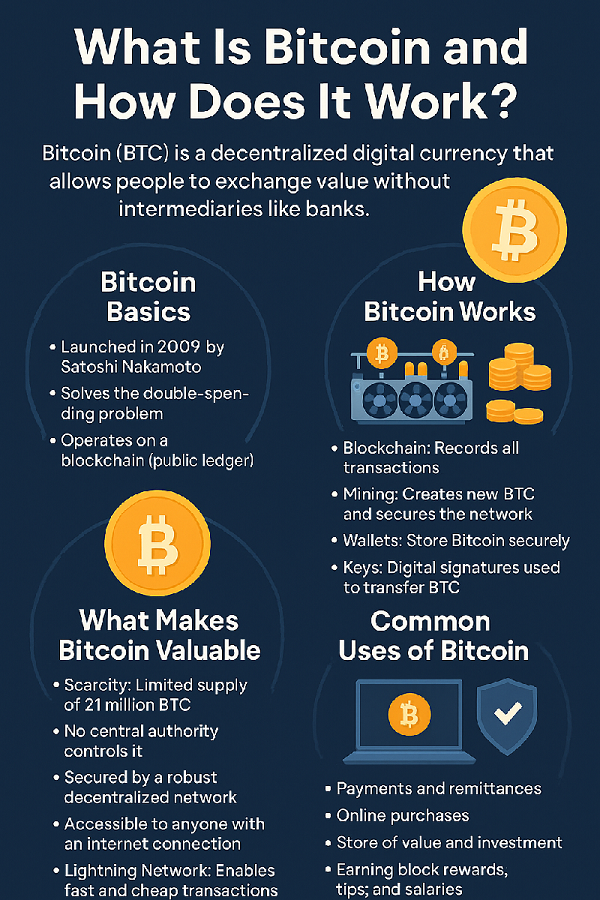Bitcoin is more than just digital money; it’s a decentralized financial network that continues to challenge traditional banking systems. Created in 2009, Bitcoin offers a transparent, borderless, and permissionless alternative to fiat currencies. But how exactly does it work, and why is it still relevant today?
Want to understand what makes Bitcoin tick, without drowning in jargon? This guide gets straight to the point. You’ll see how new bitcoins come into existence, what gives them value, and why more people around the world are turning to Bitcoin in 2025—for saving, spending, and everything in between.
Bitcoin Basics – How It All Started
Bitcoin was introduced in 2009 by an anonymous creator known as Satoshi Nakamoto, who published a whitepaper titled “Bitcoin: A Peer-to-Peer Electronic Cash System.” It sounded technical, but the core idea was refreshingly simple: let people send money to each other online—no banks, no middlemen, just direct digital value exchange.
Before Bitcoin, digital money faced the challenge of double-spending, a risk where a digital asset could be copied and reused. The solution behind Bitcoin was both simple and powerful: a decentralized ledger that guarantees each transaction is one-of-a-kind, fully verified, and permanent.
Bitcoin runs on a public system called the blockchain—a kind of digital ledger where every transaction is logged and double-checked by thousands of independent computers (or “nodes”) all over the world.
How Does Bitcoin Work?
At its core, Bitcoin is a network run by its users’ central authority, just a global system kept alive by the people who use and support it. Here’s what keeps it running:
Before looking at the components below, it’s important to understand that Bitcoin doesn’t rely on a central authority. Its power comes from a consensus-driven process, maintained by participants worldwide.
- Blockchain: A distributed digital ledger that records every transaction.
- Mining: The process of validating transactions and securing the network using computational power.
- Wallets: Software or hardware that stores your Bitcoin private keys, allowing you to send and receive funds securely.
- Private and Public Keys: These are like your password and address, used to sign and receive Bitcoin transactions.
This decentralized model makes Bitcoin highly resistant to censorship, fraud, or shutdown. Anyone can participate, verify the ledger, and even run their own full node for maximum transparency.
If you’d like to explore the technical foundations in more detail, check out the official Bitcoin.org guide on how Bitcoin works.
What Makes Bitcoin Valuable?
Bitcoin’s value doesn’t come from a central authority; it comes from a combination of scarcity, utility, and trust. Here are the main factors:
Before diving into the value factors, it’s worth noting that Bitcoin is the first truly digital asset that can’t be copied or counterfeited. This creates trust in its limited nature and predictable issuance.
- Limited Supply: There will only ever be 21 million Bitcoins.
- Decentralization: No government, company, or individual controls Bitcoin.
- Security: Backed by one of the most secure and transparent networks in the world.
- Global Accessibility: Anyone with an internet connection can use it.
- Transfer Speed and Cost (via Lightning Network): Layer-2 solutions now allow near-instant, low-cost BTC transfers.
Bitcoin is increasingly compared to gold, but with more liquidity and utility.
Common Uses of Bitcoin in 2025
While Bitcoin began as a peer-to-peer cash system, its real-world utility has expanded significantly over the years.
These are just a few of the ways people are using Bitcoin today:
- Cross-border payments: Faster and cheaper than traditional remittance services.
- Online purchases: More merchants accept BTC for digital and physical goods.
- Hedge against inflation: Especially in economies suffering from currency devaluation.
- Earning income: People earn Bitcoin via freelance work, affiliate programs, or microtask platforms.
- Donations and tipping: Content creators and nonprofits accept BTC worldwide.
Thanks to improvements in infrastructure, such as the Lightning Network and easier wallet solutions, Bitcoin is now usable even by those with no technical experience.
Is Bitcoin Safe? Key Risks and Considerations
Bitcoin’s protocol is considered highly secure, but your experience with it depends on how you use and manage it. Inexperienced users may unknowingly expose themselves to avoidable risks.
Here are key risks to be aware of:
- Volatility: Bitcoin’s price can fluctuate significantly in short timeframes.
- Wallet security: Losing your private key means losing access to your funds.
- Scams and fake platforms: Always use trusted wallets and verified services.
- Regulatory uncertainty: Some countries restrict or tax crypto differently.
For everyday users, using hardware wallets (like Ledger or Trezor), enabling two-factor authentication, and avoiding phishing links are essential safety habits.
How to Get Bitcoin – Earning vs. Buying
Most people get their first Bitcoin either by buying it on an exchange or by earning it online.
Both methods have pros and cons:
- Buying Bitcoin requires upfront money and carries the risk of price drops right after purchase.
- Earning Bitcoin may be slower, but it involves no capital and gives you hands-on experience with crypto tools.
Earning with Bitcoin has opened doors for people in countries with tight financial restrictions, and for students or freelancers building income online without relying on local systems.
What Is Bitcoin Mining?
Bitcoin mining is the process through which new Bitcoins are introduced into circulation and transactions are confirmed on the blockchain. Miners use powerful computers to solve complex mathematical puzzles, competing to add the next block.
Once a block is verified, the miner receives a block reward, currently 3.125 BTC after the 2024 halving.
Bitcoin mining in 2025 is mostly done by large operations, but individuals can still participate through mining pools or cloud mining services.
Mining also plays a key role in keeping the network secure—it spreads out control and ensures that every transaction is real and verified by the system, not a single authority.
What Is Bitcoin Halving?
Bitcoin halving is a scheduled event that reduces the block reward given to miners by 50%. It occurs roughly every four years (every 210,000 blocks). This mechanism ensures that Bitcoin’s total supply will never exceed 21 million.
- Purpose: Control inflation and ensure long-term scarcity.
- Past halvings: Took place in 2012, 2016, 2020, and most recently in 2024.
- Effect: Historically, halvings are followed by significant price increases due to reduced supply and sustained demand.
In 2025, the mining reward is 3.125 BTC per block, making Bitcoin more scarce than ever. This design mimics the deflationary nature of gold and reinforces Bitcoin’s appeal as a long-term store of value.
What Is a Bitcoin ETF?
A Bitcoin ETF (Exchange-Traded Fund) is a regulated investment product that tracks the price of Bitcoin and trades on traditional stock exchanges.
Instead of buying Bitcoin directly, investors can purchase ETF shares through brokerage accounts, gaining exposure to BTC price movements without needing to manage private keys or wallets.
Benefits of Bitcoin ETFs:
- Easier access for institutional and retail investors.
- Regulated and familiar format (like buying stocks).
- May drive more adoption and price stability over time.
Several Bitcoin spot ETFs were approved in 2024, increasing investor confidence and drawing in capital from traditional markets.
What Is Bitcoin Used For Today?
Bitcoin’s real-world applications continue to expand. While some still see it as purely speculative, it already plays a key role in:
- Personal savings and wealth protection, especially in countries with unstable currencies.
- Online payments, especially for international transactions, where credit cards fail or cost too much.
- Business transactions, with some companies paying salaries, invoices, or affiliate commissions in BTC.
- Charity and social tipping, where crypto enables borderless micro-donations.
Bitcoin is also deeply integrated into Web3, DeFi, and layer-2 ecosystems, proving that it’s far from a static store of value; it’s a growing foundation for decentralized innovation.
Conclusion
The value of Bitcoin is anchored in its scarcity, limited to 21 million coins, combined with its decentralized nature and robust security provided by blockchain technology.
With Bitcoin, people can save, transact, and participate in a digital-first economy, often without needing permission from a bank or government. No matter if you’re simply curious, a bit hesitant, or eager to explore further, Bitcoin gives you a special chance to be part of a global financial system that’s designed for the internet era.
Other Useful Guides You Might Like:
- Discover reliable task and ad-viewing platforms in our updated guide: Best Bitcoin PTC and GPT Sites
- Want to claim BTC without spending a cent? Read: How to Get Free Bitcoins Instantly
- Looking for the best faucet payouts? Check: Highest Paying Bitcoin Faucets


